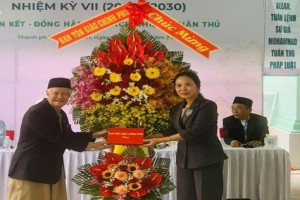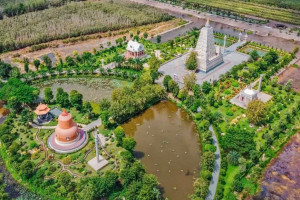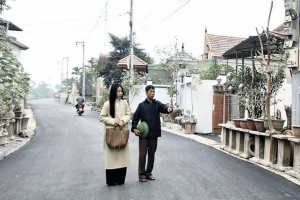
But Thap pagoda was named Ninh Phuc (early called Nhan Phap) located in Dinh To village, Thuan Thanh province, Bac Ninh town beside Duong river. It is about 25km far from Hanoi
According to the old writing, Ninh Phuc pagoda was built in Tran dynasty (in the 13th century) when Huyen Quang Zen Buddhist lived here. In the early 13th century Chuyet Chuyet monk (or called Chuyet Tong) lived in But Thap, then he had it built according to China temple style. He also built Bao Nghiem tower. Minh Hanh Tai Tai zen Buddhist of Chuyet Cong continued to expand and build more in 1647.
In 1876, Tu Duc king renamed But Thap as Nhan Thap and Bao Nghiem tower as Thap But tower.
But Thap building has the length about 150m, looking toward the south. It has 9 floors: three-door temple, shrine house, forecourt house, abstinence clearinghouse, guest house, worship house…
The first group of buildings is the three-door temple. The three-door temple of But tower has 3 spaces. The center space is larger than the two ones. Each of of the space has a row of pillars. These pillars were made of wood and brick.
From the three-door temple, walk along the paved road wide4 meters wide and 24 meters long, we come to the steeple. The steeple is a rectangular building, with 8.65 meter long and 8.20 meters width. The steeple has two floors. The downstairs has four corner walls, wood floor with open balustrade, 8 curved roof.
Walk about 15 meters; we come to forecourt where display the two big statues called Ho Phap which were made of soil and covered by paint. On the left is Thanh Tang statue and Thi Gia statue. The forecourt has 7 spaces, 32 pillars, on the corners was sculptured with dragon and cloud. The center space hang the writing made of wood "Ninh Phúc thiền tự" with the name and the title "Dương Hòa Bát niên, tuế thứ Nhâm Ngọ niên, trọng Hạ cốc đán"(good day May, 1642)
Behind the left and the right of the forecourt is the Stone stele. The Stone stele on the right is about 2.3 meters wideand 1.1 meters long, the margin of the Stone stele and the head was sculptured cloud. In the head of the Stone stele sculptured “Phật”. On the face of the Stone stele has the writing “Sắc Ninh Phúc thiền tự bi ký”. On the in front face. Beer bath built on Lotus Buddha months in Pig Phuc Thai dating to the 5th year (1647). By Minh Hanh Thich epitaph composed in At. The beer left a stone 1.6 meters high, 1 meter wide, flashing beer decorative touches topics harmony, beer forehead touched cloud dragon theme decoration. On the front face, the Stone stele was titled "Ninh Phúc thiền tự tam bảo tế tự điền bi." The inscription was in a good day of November, 1674. The back was titled and decorated as the front face, dating: a good day of the Lotus month, year the 5th year of Phuc Thai (1647). The both two Stone stele in the grave house were built on the back of the large stone turtles.
A building attaches with the forecourt building and the supreme house containing a wood bar written “chiêm vọng từ bi ". On the right it was carved dragon and entitled "Đế đạo long xương"; on the left it was carved dragon and entitled "Hoàng đồ củng cố." On the left of the roof, there is a horizontal lacquered board entitled “Đại hùng bảo điện" dating "Dương Hòa bát niên tuế thứ Nhâm Ngọ, mạnh đông cốc đán trùng tu" (good day in October 1642) and "Pháp luân thường chuyển".
The supreme house was built on high ground at about 1.1 meters above the yard, .It is19 meters long, 10.6 meters wide. It has 4 spaces and 24 iron wood pillars. The base legs are carved lotus, 4 corners with four pillars. The bottom was carved lotus, there are 4 stone pillars in the 4 corner. The stone handrail surrounding the supreme house includes 26 stone carvings; each one is about 1.2 meters long, 0.6 meters high, and 0.14 meters thick with many themes about lives in the rural delta in the north of Vietnam.
Inside the supreme house, it displays Buddha statue, Bodhisattva statue, Arhat statue. Specifically, in the centre space, there is a altar worshiping Buddha, the four Bodhisattvas, three Tam The statues; the two spaces on the right are used to worship Bodhisattva "Thiên thủ thiên nhãn," the Bodhisattva Manjushri statue riding a crocodile, a Bodhisattva statue, the nine Arhat statues, Quan Am Thi Kinh statue; the two spaces on the left display Tuyet Son statue, statues, Bodhisattva Samantabhadra riding elephant, a Bodhisattva statue, and the nine Arhat statues, Y Lan Queen.
The supreme house connects with Thien Am temple by a curved stone bridge 4.1 meters long. This bridge includes 3 downstairs, with three stone steps leading to Thien Am temple. The bridge has a stone handrail with 12 stone carvings on the 2 both sides with the theme of rural landscape. Both the 2 sides have tanks planting lotus.
Thien Am temple is a unique architecture. The building has three- layer roof. The first layer which covers 7 spaces is rectangle, 16.1 meters long, and 8.4 meters wide. The rest layers are narrow down, forming a square. In the center of Thien Am temple, there is Cửu phẩm hoa liên tower which was made of wood, lacquer trimmed with gold. In this tower, there are 32 carvings each layer and several small Buddha statues at the edges. Cửu phẩm hoa liên tower has an axis so that it can be turned according to clock direction. In the right space, there are Buddha Amitabha statue and the grave entitled "Tích thiện am”. It dated "Chính hòa thập nhị niên tuế thứ Tân Mùi, thập nhất nguyệt, cốc nhật lương thời thủy tạo" (it was made at the first time on a good day, November 1691). The left space includes Buddha Amitabha statue.
Walk about 7 meters from Thien Am temple; we come to the second major group of buildings. This group of buildings includes three parallel buildings: guest houses, worship house, and the post court. The guest house has 5 spaces. On the wall of the guest house there is a board entitled "This house was restored with financial and technical help of Ministry of Foreign Affairs of the Federal Republic of Germany in the years from 1990 to 1998".
After waking through a 3 meter yard, it is worship house. The worship house has 5 spaces, 16.5 meters long, 9 meters wide. In the center space, there is altar worshiping Trinh Thi Ngoc Truc queen. In the right there is an altar worshiping Le Thi Ngoc Duyen princess. The last space on the right, there is stele entitled "Khánh lưu bi kí" 1.6 meters high and 0.70 meters wide; the edge of the stele was carved dragon, flower and leaf. It was built in 1714 dating the 10th Vinh Thinh. The back is titled "Ninh Phúc thiền tự bi ký”. Near the wall, there are 5 Pluto statues long forward to the center space. In the left space, there is an altar worshiping Trinh Thi Ngoc Co. In the last space, there is an altar to worship Le Dinh Tu prince; near the wall, there are 5 Pluto statues looking forward to the center space. These statues are opposite to the Pluto statues on the right.
The ancestor house and worship house include13 spaces (6 worship spaces). This building is 26.5 meters long, 7.7 meters wide. In the center space, there is the ancestor statue. Upper the statue it is the horizontal lacquered board entitled "The Tổ ấn trùng quang". On the two columns hang the parallel sentences:
- Đức nhi báo đức thường nhiên, ngũ phận chân hương,
- Tâm dĩ truyền tâm tận phẫu, nhất thừa diệu đạo.
In the two spaces on the right, there are six statues and a photo of the ancestor. In the two spaces on the left, there are altars worshiping the 5 Gods of soil, the 3 god mothers and the 4 kings.
Besides the two main groups of buildings above, But Thap pagoda also has and some distinguishing buildings:
- The two blocks along the corridor, each blocks has 26 spaces, each one is 2.6 meters long, 4 meters wide. (Newly built in the 1990 - 1998)
The house to worship the first ancestor Chuyet Cong is on the back of the corridors (from the outside). This building has 5 spaces, 13 meters long, 6.8 meters wide. The center space there is an altar to worship Chuyet Cong ancestor. In the rest spaces, there are altars to worship the 3 ancestors and one 2 meter high and 1 meter wide stele. The forehead of the stele was decorated two dragons flanking the sun; the edge was carved dragon and clouds, the front side was titled "Hiển thụy am- Báo nghiêm tháp bi ký". The stele was made in the 5th year Phuc Thai (1647), by Minh Hanh who lived in Hung Cong, composed by Thanh Nguyen, written by Sadi Chan Kiem who lived in Phu Chan Dong Ngan. The back of the stele was titled "Hiến thụy am hương hỏa điền bi ký". In the two spaces on the left, there are altar to worship ancestor and the prince. Beside the altar to worship the prince, we can find parallel sentences:
- Tướng phủ đốc sinh khoa quốc sắc,
- Vương cung nhập thị thiền thiên hương.
In addition to the above beautiful structures, But Thap pagoda has much more beautiful ones. Specifically, they are Bao Nghiem and Ton Duc towers. Bao Nghiem tower was built of blue stone, in an octagonal style, 13.05 meters high. It consists of 5 floors and a roof. On the pedestal of the tower, there are Chuyet Cong statue, and the door. The tower has 13 carvings on stone with the lively theme. In the corner of each floor hangs Phong lệnh. Ton Duc tower contains bronze books. The books were made from the eighteenth century, related to Queen Trinh Thi Ngoc Truc.
Regarding the value of wood sculpture, we must firstly mention the works of art Guan Yin Bodhisattva with hundred hands and eyes. This is a sculpture in the Le reign by Mr Truong. In the carved block carved such as the body of the statues, pedestals, tables, arms were linked together harmoniously, tightly. The entire statue is 3.7 meters high. Guan Yin Bodhisattva with hundred arms and eyes has 11 arms which were very well arranged around the body, forming leaf corona like Bodhi leaf. In each hand there is an eye.
The pedestal of the statue is square and decorated skilful. On the pedestal is decorated with a wave of water and the sea monster handing lotus.
Most of the statues, stone and wood carvings, wood altars in But Thap pagoda are works of art of the 17th and 18th century.
But Thap Pagoda has been approved as the Architectural monuments of art in Decision No. 313/VH-BT April 28, 1962 of Ministry of Culture. This is one of the typical pogoda in Vietnam and is one of the few temples preserving many precious artifacts in Le reign.




